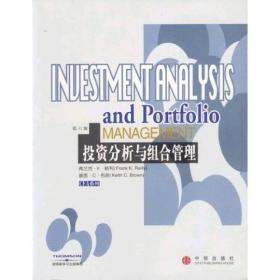
投资分析与组合管理
¥ 26.75 4.1折 ¥ 65 九五品
仅1件
作者(美)赖利,(美)布朗 著,陈志娟,马长峰 改编
出版社高等教育出版社
ISBN9787040426014
出版时间2015-07
版次1
装帧平装
开本16开
纸张胶版纸
页数663页
定价65元
上书时间2024-05-28
- 最新上架
商品详情
- 品相描述:九五品
- 商品描述
-
基本信息
书名:投资分析与组合管理
定价:65元
作者:(美)赖利,(美)布朗 著,陈志娟,马长峰 改编
出版社:高等教育出版社
出版日期:2015-07-01
ISBN:9787040426014
字数:
页码:663
版次:1
装帧:平装
开本:16开
商品重量:
编辑推荐
内容提要
根据高等教育出版社拟定的“经济管理类双语教学教材改编的总体设想及安排”中的改编原则,改编后的《投资分析与组合管理》教材在保持原版教材原汁原味的基础上,力求将篇幅压缩在500页以内,使之更适合中国普通高等学校相关专业本科生的教学和学习。具体的改变工作主要考虑了一下几点:1.为了保持知识结构的完整性,删除的内容集中在每章最后部分的summary、questions、过多的习题、Appendix;2.删除了关于衍生品的分析部分,该内容有专门的教材,以突出本书的重点;3.删除了关于美国市场介绍的内容;增加关于中国及其周边市场的介绍;4.将教材最后部分的术语表中的术语译成中文;5.改编后教材中的章节序号和页码需要进行系统性调整。
目录
PART 1 THE INVESTMENT BACKGROUND Chapter 1 The Investment Setting 1.1 What Is an Investment? 1.2 Measures of Return and Risk 1.3 Determinants of Required Rates of Retur 1.4 Relationship between Risk and Retur Chapter 2 The Asset Allocation Decisio 2.1 Individual Investor Life Cycle 2.2 The Portfolio Management Process 2.3 The Need For a Policy Statement 2.4 Input to the Policy Statement 2.5 The Importance of Asset Allocatio Chapter 3 Selecting Investments in a Global Market 3.1 The Case for Global Investments 3.2 Global Investment Choices 3.3 Historical Risk-Returns on Alternative Investments Chapter 4 Organization and Functioning of Securities Markets 4.1 What Is a Market? 4.2 Primary Capital Markets 4.3 Secondary Financial Markets 4.4 Detailed Analysis of Exchange MarketsPART 2 DEVELOPMENTS IN INVESTMENT THEORY Chapter 5 Efficient Capital Markets 5.1 Why Should Capital Markets Be Efficient? 5.2 Alternative Efficient Market Hypotheses 5.3 Tests and Results of Efficient Market Hypotheses 5.4 Behavioral Finance 5.5 Implications of Efficient Capital Markets Chapter 6 An Introduction to Portfolio Management 6.1 Some Background Assumptions 6.2 Markowitz Portfolio Theory Chapter 7 An Introduction to Asset Pricing Models 7.1 Capital Market Theory: An Overview 7.2 The Capital Asset Pricing Model 7.3 Relaxing the Assumptions 7.4 Additional Empirical Tests of the CAPM 7.5 The Market Portfolio: Theory Versus Practice Chapter 8 Multifactor Models of Risk and Retur 8.1 Arbitrage Pricing Theory 8.2 Multifactor Models and Risk EstimationeePART 3 VALUATION PRINCIPLES AND PRACTICES Chapter 9 Analysis of Financial Statements 9.1 Major Financial Statements 9.2 Analysis of Financial Ratios 9.3 Computation of Financial Ratios 9.4 Evaluating Internal Liquidity 9.5 Evaluating Operating Performance 9.6 Risk Analysis 9.7 Analysis of Growth Potential 9.8 Comparative Analysis of Ratios 9.9 The Value of Financial Statement Analysis 9.1o Specific Uses of Financial Ratios Chapter lo An Introduction to Security Valuatio 10.1 An Overview of the Valuation Process lO.2 Why a Three-Step Valuation Process? lO.3 Theory of Valuatio lO.4 Valuation of Alternative Investments lO.5 Relative Valuation Techniques lO.6 Estimating the Inputs: The Required Rate of Return and the Expected Growth Rate of Valuation VariableseePART 4 ANALYSIS AND MANAGEMENT OF COMMON STOCKS Chapter 11 Macroanalysis and Microvaluation of the Stock Market 11.1 The Components of Market Analysis 11.2 Macromarket Analysis 11.3 Microvaluation Analysis 11.4 Valuation Using the Earnings Multiplier Approach 11.5 Estimating Expected Earnings per Share 11.6 Estimating the Stock Market Earnings Multiplier 11.7 Microvaluation of World Markets Chapter 12 Industry Analysis 12.1 Why Do Industry Analysis? 12.2 The Business Cycle and Industry Sectors 12.3 Structural Economic Changes and Alternative Industries 12.4 Evaluating the Industry Life Cycle 12.5 Analysis of Industry Competitio 12.6 Estimating Industry Rates of Retur 12.7 Industry Analysis Using the Relative Valuation Approach 12.8 Other Relative Valuation Ratios 12.9 Global Industry Analysis Chapter 13 Company Analysis and Stock Valuatio 13.1 Company Analysis versus Stock Valuatio 13.2 Economic, Industry, and Structural Links to Company Analysis 13.3 Company Analysis 13.4 Estimating Intrinsic Value 13.5 Analysis of Growth Companies 13.6 Measures of Value Added 13.7 Influences on Analysis 13.8 Global Company and Stock Analysis Chapter 14 Technical Analysis 14.1 Underlying Assumptions of Technical Analysis 14.2 Advantages of Technical Analysis 14.3 Challenges to Technical Analysis 14.4 Technical Trading Rules and Indicators Chapter 15 Equity Portfolio Management Strategies 15.1 Passive versus Active Management 15.2 An Overview of Passive Equity Portfolio Management Strategies 15.3 An Overview of Active Equity Portfolio Management Strategies 15.4 Value versus Growth Investing: A Closer Look 15.5 An Overview of Style Analysis 15.6 Asset Allocation StrategiesPART 5 ANALYSIS AND MANAGEMENT OF BONDS Chapter 16 Bond Fundamentals 16.1 Basic Features of a Bond 16.2 The Global Bond Market Structure 16.3 Alternative Bond Issues 16.4 Obtaining Information on Bond Prices Chapter 17 The Analysis and Valuation of Bonds 17.1 The Fundamentals of Bond Valuatio 17.2 Computing Bond Yields 17.3 Calculating Future Bond Prices 17.4 Bond Valuation Using Spot Rates 17.5 What Determines Interest Rates? 17.6 Calculating Forward Rates from the Spot Rate Curve 17.7 Term-Structure Theories 17.8 What Determines the Price Volatility for Bonds? 17.9 Yield Spreads with Embedded Options Chapter 18 Bond Portfolio Management Strategies 18.1 Bond Portfolio Performance, Style, and Strategy 18.2 Passive Management Strategies 18.3 Active Management Strategies 18.4 Core-Plus Management Strategies 18.5 Matched-Funding Management Strategies 18.6 Contingent and Structured Management StrategiesPART 6 SPECIFICATION AND EVALUATION OF ASSET MANAGEMENT Chapter 19 Professional Money Management, Alternative Assets, and Industry Ethics 19.1 The Asset Management Industry: Structure and Evolutio 19.2 Private Management and Advisory Firms 19.3 Organization and Management of Investment Companies 19.4 Investing in Alternative Asset Classes 19.5 Ethics and Regulation in the Professional Asset Management Industry 19.6 What Do You Want from a Professional Asset Manager? Chapter 20 Evaluation of Portfolio Performance 20.1 What Is Required of a Portfolio Manager? 20.2 Composite Portfolio Performance Measures 20.3 Application of Portfolio Performance Measures 20.4 Portfolio Performance Evaluation: Some Extensions 20.5 Factors That Affect Use of Performance Measures 20.6 Evaluation of Bond Portfolio Performance 20.7 Reporting Investment Performance Glossary FREQUENTLY USED SYMBOLS
作者介绍
序言
-

【封面】
相关推荐
— 没有更多了 —

















以下为对购买帮助不大的评价